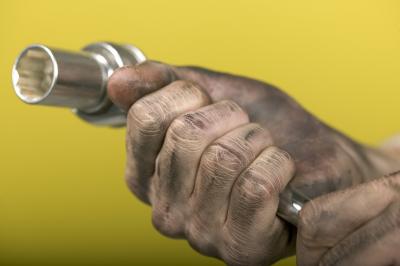
The Honda Pilot was manufactured starting in the summer of 2002 as a 2003 model. It features front and rear disc brakes. There may be many reasons why you must remove or replace the brake rotors on the SUV. The procedures to remove the front or rear rotors are similar, but there is one significant difference between the two.
Before lifting the Pilot, siphon about half of the brake fluid from the master cylinder in the engine compartment. Any time you remove the calipers, you must compress the hydraulic pistons in with a C-clamp or caliper tool. This will purge the fluid back through the system and into the master cylinder. If the cylinder is full, the fluid will overflow.
Apply the parking brake before lifting and removing the front brake assembly on the Pilot. Be sure to support the SUV onto jack stands and not just the jack.
After you've removed the wheels, locate and remove the caliper bolts from both the upper main pin and the lower sub pin. Extract the pins from the caliper. Note that the upper pin has a rubber bushing on the end, so be sure when you replace the pins that you put them in the proper location. Gently pry the caliper off the pads and rotor. Be careful of the pad springs, as you'll need to reuse them.
Compress the caliper pistons (Pilots feature dual piston calipers), using a suitable caliper piston tool or a large C-clamp, then hang the caliper to the coil spring with a hook or a wire. This will prevent damage to the rubber brake hose attached to the caliper. On the back of the knuckle are the caliper anchor bolts. Remove these in order to remove the anchor so you can remove the rotor.
Note on the hub face of the rotor that there is a Phillips-head retaining screw. Remove this using an impact screwdriver and a hammer to break it free from the hub. Then pull the rotor straight off the hub. It's not uncommon for rotors to become stuck to the hub because of corrosion or rust. If this is the case, spray penetrating lubricant onto the hub and rotor mating surface, and allow it to soak in. To remove the rotor, you'll have a couple of different options. You can shock it off the hub using a dead-blow hammer. If you're replacing the rotor, this is a viable option. However, if you intend to reuse the rotor, you do not want to damage it by striking it with a hammer. On the hub facing where the rotor retaining screw was located, you'll notice two smaller screw holes opposite each other. Insert the appropriate threaded bolts into these holes, and tighten them alternately a couple of turns each until the rotor separates from the hub so that you can remove it by hand.
The rear rotors will follow a similar procedure to remove. One significant difference is that the rear rotors employ internal brake shoes integrated with the parking brake system. Do not apply the parking brake when removing the rear rotors, or they will be stuck to the brake shoes. In addition, use caution when it comes time to remove the rotor in the event the internal hub is stuck to the parking brake shoes, or you could damage the shoes.
If you're replacing new rotors, clean them with a brake clean spray. Rotors feature a rust preventive coating so they will not rust from condensation in the air while stored on the parts shelves. If you don't clean it off, this coating can damage the surface of pads and cause a great deal of smoke when you apply the brakes.
If you're replacing the same rotors you removed, mark a wheel stud and the rotor so that you replace it in the same position on the hub flange you removed it from. This will prevent run-out problems.
Torque all the caliper anchor bolts, caliper bolts and lug nuts to the proper torque specifications. Pump the brake pedal several times when the Pilot is back onto the ground and before you attempt to drive the vehicle. Compressed caliper pistons will not respond if not seated properly, and you will have no brake pedal right away. Once the brake pedal feels normal, recheck and refill the master cylinder using only new brake fluid.